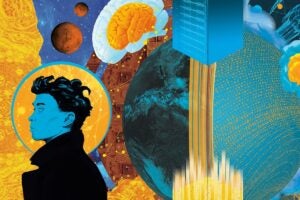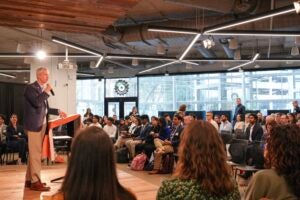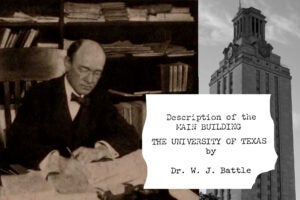The University of Texas at Austin’s Dell Medical School announced today that it has received preliminary accreditation from the Liaison Committee on Medical Education, which means the school can officially start accepting applications for its inaugural class to begin summer 2016.
[Apply to be in the inaugural class of UT’s Dell Medical School.]
What can students expect if they enroll in the first new medical school in decades to be opened at a Tier 1 research university?
They’ll get an education thoughtfully crafted from scratch around the realities of modern medicine, says Dr. Clay Johnston, Dell Medical School’s inaugural dean. More than 250 UT Austin faculty, Austin-area physicians, residency program directors, education experts and others played a role in developing the signature curriculum.
“The curriculum pulls from the most creative and effective teaching practices nationwide and adds new innovations to ensure that our students get an education that reflects the challenges and opportunities of 21st century medicine,” says Dr. Susan Cox, executive vice dean for academics and chair of medical education.
[Subscribe to the Dell Med newsletter and stay connected via Twitter, Facebook and the website.]
“Our groundbreaking curriculum is designed to train and support physician leaders who are as comfortable taking on transformational health challenges as they are caring for patients,” Cox says.
The curriculum will emphasize student centered small-group and team-based learning over lectures. It also is fully integrated, meaning it uses real-world, case-based, interdisciplinary challenges that connect lessons students learn in different courses. For example, nutrition isn’t learned as a singular element; rather, a focus on nutrition and its impact is a crosscutting element for a variety of lessons and courses.
Year 1 |
Preclinical scientific foundations of medicine (Molecules and Cells, Structure and Function, Brain and Behavior, Foundations and Mechanisms of Disease). |
|---|---|
Year 2 |
Clinical sciences with continued scientific and health-care delivery education (Internal Medicine, Psychiatry/Neurology, Women’s Health, Pediatrics, Surgery, and Community and Preventive Medicine). |
Year 3 |
Innovation, Leadership and Discovery year, a signature curriculum element through which students focus their studies in an individual area of interest and either pursue a dual-degree or produce a capstone project. |
Year 4 |
Internship-level experiences and clinical electives. |
Here are five ways the Dell Medical School curriculum will transform medical education to better prepare students for the 21st century health care landscape:
Educational Flexibility

Dell Medical School will offer numerous opportunities for students to personalize their educational experience. Given the student-centered approach to the preclinical year, students determine their own objectives for clinical cases. During the third year, students will have the option of pursuing a dual degree, such as a master’s degree in business administration, public health or biomedical engineering.
“We wanted to carve out time for people to focus on challenges they’re passionate about solving,” Johnston explains.
Students will also have the opportunity to schedule clinical experiences of personal interest during the second and third years, allowing for early career exploration and greater customization of the educational experience.
Commitment to Innovation

This third year of a Dell Medical School student’s education, known as the “Innovation, Leadership and Discovery Year,” is a signature element of the curriculum — nothing like it is known to exist at any other medical school.
[Related: Design Institute for Health Brings Creativity to Health Ecosystem]
Students will work on projects related to care delivery redesign, population health and informatics, or more traditional research. Students will be encouraged to take on difficult, systematic challenges that undermine health and perpetuate waste in the system.
“We created a curriculum not for the kind of health care we deliver today, but for the kind we want to deliver in the future,” Johnston says.
For the population health track, students will join multidisciplinary teams focused on identifying solutions to priority health risks in Austin, working alongside Central Health, Travis County’s health district. For care redesign, the students will be key members of diverse teams addressing a fundamental issue in care delivery (such as transitions in care, pre-op screening or overuse of imaging), working in conjunction with the school’s key partners. For the discovery/translation option, students may join a research group as a key member of the team.
Focus on Leadership Development

The Dell Medical School curriculum aims to create a new type of physician leader — one driven by the opportunity to inspire other physicians and revolutionize the health care environment.
“Physicians of the future need to be able to look around at the system and say, ‘What’s wrong? What’s broken with our system? How can we restructure it to better meet the health needs of patients?'” Johnston says.
The curriculum is built around student learning, not faculty teaching, meaning students will help guide their own education by identifying learning objectives and managing their approaches to achieving those objectives. And a required leadership curriculum is being developed as a core experience for all third-year students. The medical school will also focus on student-centered exercises and problem-solving skills, rather than minutia and memorization.
“Things are changing so rapidly it’s impossible to know everything, and kids today know this,” Johnston says. “We used to memorize telephone numbers, but there’s no reason to memorize a telephone number anymore. And the same is true for many facts you’re faced with as a physician. That’s really about how you learn and what tools do you use, not what knowledge do you rely on in your head.”
Groups of students will be matched with highly trained physician mentors who will follow them over their entire student experience. Medical students will also become very familiar with other health care professions and their contributions to high-quality and safe patient care, so they will more easily gravitate toward team-based health care and instinctively work collaboratively with other professions.
“More and more there’s a recognition that team-based care makes sense, but we need it to be part of the culture of health care from the very beginning,” Johnston explains.
Integrating Technology in Medicine

“Academic medicine must redefine itself as a steward of technological advancement in the community,” says Mini Kahlon, vice dean of strategy and partnerships at the Dell Medical School.
Students will explore technological advancements that incorporate medtech innovation in both clinical settings and the day-to-day lives of people across the community.
From day one, electronic health records will play a part in the curriculum, giving students a thorough understanding of an important component of clinical life that until recently has largely been overlooked in medical school preclinical years.
Students will also be exposed to the latest real-world technologies and strategies for treating health problems while training in the new Seton Medical Center at UT Austin, to be completed in 2017.
Student Presence in the Community

By participating in longitudinal community and preventive medicine programs, students will gain a fuller education — medical and otherwise — while helping to fill gaps in community access and outreach. “Longitudinal” primary care experiences allow students to follow the same patients through specific community providers and clinical sites to gain greater insight into the prevention and management of disease and chronic health issues over time.
Key affiliations are a cornerstone of Dell Medical School’s mission. Community-focused partnerships allow the school to make connections between academic medicine and the surrounding community to improve health outcomes.
The school is working with Huston-Tillotson University (HT) to create the Sandra Joy Anderson Community Health and Wellness Center at HT, which will increase access to health care — and especially mental and behavioral health care — to historically underserved residents in East Austin and across Travis County.
“It will give our students the chance to learn and help our neighbors to get healthy and stay healthy, and it will allow our two universities to collaborate with the community in developing new, culturally appropriate models of care,” Johnston says.
[Related: National Psychiatric Leader Will Run Joint Program]
The partnership demonstrates each institution’s commitment to improving health and increasing access to care throughout underserved communities in Travis County, while also improving integrated behavioral and general health education on both campuses.
“Our focus is on enabling an entire ecosystem to improve health,” Kahlon says.



